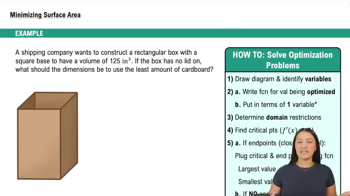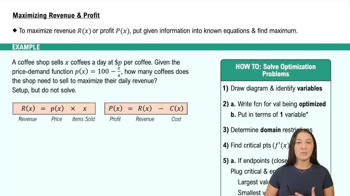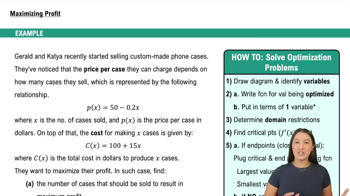Table of contents
- 0. Functions7h 52m
- Introduction to Functions16m
- Piecewise Functions10m
- Properties of Functions9m
- Common Functions1h 8m
- Transformations5m
- Combining Functions27m
- Exponent rules32m
- Exponential Functions28m
- Logarithmic Functions24m
- Properties of Logarithms34m
- Exponential & Logarithmic Equations35m
- Introduction to Trigonometric Functions38m
- Graphs of Trigonometric Functions44m
- Trigonometric Identities47m
- Inverse Trigonometric Functions48m
- 1. Limits and Continuity2h 2m
- 2. Intro to Derivatives1h 33m
- 3. Techniques of Differentiation3h 18m
- 4. Applications of Derivatives2h 38m
- 5. Graphical Applications of Derivatives6h 2m
- 6. Derivatives of Inverse, Exponential, & Logarithmic Functions2h 37m
- 7. Antiderivatives & Indefinite Integrals1h 26m
- 8. Definite Integrals4h 44m
- 9. Graphical Applications of Integrals2h 27m
- 10. Physics Applications of Integrals 2h 22m
5. Graphical Applications of Derivatives
Applied Optimization
Problem 4.5.30
Textbook Question
Shortest ladder A 10-ft-tall fence runs parallel to the wall of a house at a distance of 4 ft. Find the length of the shortest ladder that extends from the ground to the house without touching the fence. Assume the vertical wall of the house and the horizontal ground have infinite extent.
 Verified step by step guidance
Verified step by step guidance1
Visualize the problem by drawing a diagram: a vertical wall, a horizontal ground, and a fence parallel to the wall. The ladder must reach from the ground to the wall without touching the fence.
Define the variables: Let x be the horizontal distance from the base of the ladder to the wall, and y be the vertical distance from the top of the ladder to the ground. The ladder forms a right triangle with the ground and the wall.
Use the Pythagorean theorem to express the length of the ladder L in terms of x and y: L = sqrt(x^2 + y^2).
Consider the constraint given by the fence: The ladder must not touch the fence, which is 4 ft away from the wall. This means the base of the ladder must be at least 4 ft away from the wall, so x >= 4.
To find the shortest ladder, minimize the function L = sqrt(x^2 + y^2) subject to the constraint x >= 4. Use calculus techniques such as differentiation to find the minimum value of L.
 Verified video answer for a similar problem:
Verified video answer for a similar problem:This video solution was recommended by our tutors as helpful for the problem above
Video duration:
14mPlay a video:
Was this helpful?
Key Concepts
Here are the essential concepts you must grasp in order to answer the question correctly.
Optimization
Optimization in calculus involves finding the maximum or minimum values of a function. In this problem, we need to minimize the length of the ladder while adhering to the constraints of the fence and the wall. This typically involves setting up a function that represents the length of the ladder and using techniques such as derivatives to find critical points.
Recommended video:

Intro to Applied Optimization: Maximizing Area
Related Rates
Related rates are used in calculus to find the rate at which one quantity changes in relation to another. In this scenario, the relationship between the height of the ladder, the distance from the fence, and the height of the fence can be analyzed using related rates to derive the necessary equations for optimization.
Recommended video:

Intro To Related Rates
Geometric Relationships
Understanding geometric relationships is crucial for visualizing the problem. The ladder, fence, and wall form a right triangle, where the ladder acts as the hypotenuse. By applying the Pythagorean theorem, we can relate the lengths of the sides of the triangle to derive an equation that can be optimized to find the shortest ladder length.
Recommended video:

Derivatives Applied To Velocity

 1:13m
1:13mWatch next
Master Intro to Applied Optimization: Maximizing Area with a bite sized video explanation from Callie
Start learningRelated Videos
Related Practice








